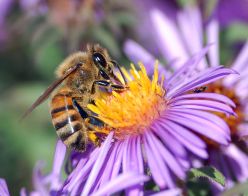
But what do the data reveal? Are honeybee numbers falling? Is honey production in a tailspin? This week Randal Rucker, professor of economics and agricultural economics at Montana State University, answers these questions and more. Professor Rucker is a Lone Mountain Fellow at PERC working on projects related to pollination markets and colony collapse disorder. He has published research on various issues related to agricultural policy, contracting, and natural resource management, and is co-author with Ernest C. Pasour Jr. of Plowshares & Pork Barrels: The Political Economy of Agriculture.
We thank Dr. Rucker for taking the time to answer our questions. For more of PERC’s ongoing Q&A series, see the Q&A series archive.
Q: How is colony collapse disorder (CCD) affecting bees and beekeepers?
A: With CCD, a beekeeper will check his hive one day and find it to be healthy. When he comes back to check it again, those hives that have been hit by CCD will have few or no adult bees present. The queen often remains, the colony contains food, and there is brood remaining. The adult bees are nowhere to be found.
CCD has increased the costs of beekeeping. Commercial beekeepers now make more splits (see below) going into the winter. If a beekeeper does not get hit by CCD, then he probably has more hives in the spring than he had going into the winter. If he gets hit by CCD then he may lose half or more of his colonies. In this case, if he has contracts to pollinate almonds in the spring, he will have difficulty fulfilling those contracts.
Q: Why do you think the media portrayed CCD as a “crisis” and in turn the public presumed that government action is desirable or necessary?
A: CCD is a crisis for those beekeepers that get hit hard by CCD. In aggregate, however, our research suggests that most market indicators have not changed noticeably since the onset of CCD. Colony numbers have not fallen, honey prices have not risen, package and queen prices have not shown dramatic increases, and honey production and yields have not been affected. With the exception of almond fees, pollination fees have not changed much since the fall of 2006 when CCD first appeared. Our analysis suggests that almond pollination fees have risen (by roughly 10 to 15 percent) since the appearance of CCD.
Why has the media portrayed CCD as a crisis? Possibly because most people do not understand how beekeeping and pollination markets work. There has been limited acknowledgement in the press that beekeepers lose bees every winter and that they know how to deal with those losses.
Q: How is CCD affecting pollination markets?
A: As indicated above, most of the market measures you can think of that might indicate a crisis have not changed much. The back-of-the-envelope calculations we have done to date suggest that the increase in almond pollination fees we have found probably causes the retail price of a $7 one pound can of Blue Diamond almonds to increase by about three cents.
Q: How do beekeepers adapt to increased mortality in their bee colonies?
A: There are several methods by which commercial beekeepers can increase their colony numbers to offset the potential increase in winter mortality since the onset of CCD. Our surveys of Washington and Oregon beekeepers suggest that the most frequently used method has been splitting and re-queening. Beekeepers can split a healthy hive by taking up to half the colony’s population, and placing those bees in an empty colony. They purchase a queen for the new colony and have it delivered through the mail. The process of transferring the bees to a new colony takes a good commercial beekeeper about twenty minutes. Today, the queen might cost them $15 – $20. Depending on how many bees were extracted from the original colony, it can be at sufficient strength to provide pollination services within a relatively short time period. Within about six weeks, the new colony will be at full strength.
Q: What lessons can we draw from the adaptation of beekeepers?
A: Markets work. Honey bees are resilient, and commercial beekeepers are savvy businessmen who have figured out how to respond to the problems caused by CCD. The data on the market indicators mentioned above suggest that beekeepers have adapted to this new disease quickly.
Q: Steven Levitt and Stephen Dubner briefly discuss beekeepers in their recent best seller Super Freakonomics. They claim that fruit farmers and beekeepers create positive externalities for one another, and for that reason they set up shop next to one another. Is their assessment of the relationship between beekeepers and orchard owners accurate?
A: No. There are commercial beekeepers who manage thousands of colonies and travel thousands of miles each year to provide pollination services to orchard owners and farmers with crops that require these services. The classic story about beekeepers not receiving any benefits from the pollination services provided by their bees is a myth. Our research suggests that the first pollination contracts were probably negotiated in the early 1900s. Prior to that, the description provided in Super Freakonomics may have been accurate in some instances, although we suspect that at least as frequently orchard owners and farmers may have simply owned a few bee colonies to provide the (smaller scale) pollination services they required.



